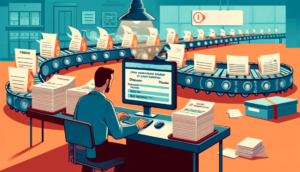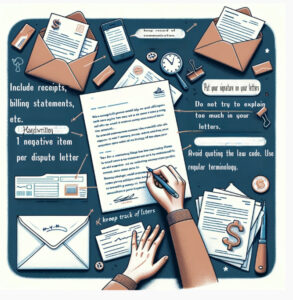A Comprehensive Guide to Disputing Derogatory Items with Credit Bureaus
The majority of the links on our website are affiliate links. This means that if you click on the link and make a purchase, we earn a small commission at no additional cost to you.
Introduction

Remember this word Frivolous, it means nonsense. If the credit bureaus can determine a dispute is frivolous, they are not required to do anything. That’s their focus because they are just businesses trying to make a profit like any other business. Businesses try to reduce their expenses for many reasons. One of those reasons is to increase the profit margin.
Consumers are not the credit bureaus’ customers. We do not pay their bills. The “furnishers” do. They are the credit bureaus’, main concern. They bring in more revenue for them than any other areas of their business. Furnishers are the banks, lenders, and creditors. The only concern towards consumers is how can they reduce the cost of investigations.
The Reality of Credit Bureaus
Unless you are wealthy, consumers cannot avoid having a credit history. And we have no say in whether our information is included in the credit bureaus’ databases. We cannot take our information and go somewhere else with it.
Whereas the furnisher can switch between the credit bureaus if they want. Reporting to the credit bureaus cost creditors money. Equifax does not want to lose a creditor to TransUnion. Which can happen if a credit bureau conducts thorough investigations.
The credit bureaus blame credit repair businesses as the reason for their careless investigations. They say that credit repair companies generate frivolous disputes. The make promises of removing valid negative information from consumers reports. About 30% of credit disputes involve credit repair businesses, but they assume every dispute is like this, trying to remove valid negative information.
They know very well you can’t assume every dispute involves a credit repair business. And they do not all try to remove valid negative information. But that still doesn’t explain why they conduct meaningless investigations. It might be a fraction of the reason why, but the real reason is because they are too expensive and undermine their paying customers efforts to collect money from borrowers
Credit bureaus don’t prioritize consumers because credit disputes are a business expense. They are spending money on people who are not their customers.
Conducting real investigations could harm furnishers efforts to collect debts from people. In other words, investigating disputes could reveal that some debts are incorrect or unfair, making it harder for them to collect those debts.
Careless investigations reduce the cost burden of investigations. And they don’t ruin the chances of furnishers collecting their money. They are going to keep their paying customers happy rather that help the consumer. Whatever the furnisher’s say goes.
The Fair Credit Reporting Act (FCRA)
 The Fair Credit Reporting Act was passed in 1970 to address several issues related to consumer credit information. One of the issues being accuracy. It’s supposed to promote the accuracy, fairness, and privacy of consumer information contained in the files of credit bureaus.
The Fair Credit Reporting Act was passed in 1970 to address several issues related to consumer credit information. One of the issues being accuracy. It’s supposed to promote the accuracy, fairness, and privacy of consumer information contained in the files of credit bureaus.
Here are reasons an account can be deleted:
- Incorrectly reporting an account that does not belong to you.
- Incorrectly reporting a late payment.
- Inaccurate reporting of the account date.
- Reporting an outdated negative account.
- Incomplete reporting due to missing information.
- Reporting information that cannot be verified.
Important Facts – 54 Years Later:
- 79% of credit reports contain errors.
- 54% include personal information that is incorrect.
- 22% of reports have loans that were listed twice.
- 8% of reports were missing positive credit information that boosts credit scores.
6 million Americans have errors on their credit reports. Not everyone is disputing errors. I would make a bet that majority of them don’t even know that there is an error. Let’s say only 3 million requested disputes. That is a lot of money. Let’s say half of that resulted in valid errors and needed to be deleted. Thats a lot of money furnishers are not going to be able to collect. This may seem hopeless, but this information can be used to your advantage. You now know that they do not conduct a thorough investigation. That information is going to come in handy later on.
Understanding the Law
 Let’s talk about the t law. Credit reports must be 100% accurate. Accurate information cannot be removed from a consumer’s file. People are not perfect, and the credit bureaus employ a lot of people. Of course, errors are going to happen now and again, that’s understandable. The FCRA allows consumers a way to fix the errors that have been made. One thing to remember is that a consumer must exercise their rights. It’s the only way to hold the credit bureaus accountable.
Let’s talk about the t law. Credit reports must be 100% accurate. Accurate information cannot be removed from a consumer’s file. People are not perfect, and the credit bureaus employ a lot of people. Of course, errors are going to happen now and again, that’s understandable. The FCRA allows consumers a way to fix the errors that have been made. One thing to remember is that a consumer must exercise their rights. It’s the only way to hold the credit bureaus accountable.
The FCRA says the credit bureaus are required by law to investigate consumer disputes submitted in writing within 30 days plus mail time. The FCRA has not been updated to include telephone or online disputing. Assume that you lose your rights if you dispute any other way than USPS mail. Disputing by phone or online puts you in harm’s way in terms of your dispute being labeled as frivolous.
Ignoring a valid dispute letter is a violation for the credit bureaus. But if the credit bureaus determine your dispute to be frivolous or nonsense, they are not required to investigate.
What Makes a Dispute Frivolous?
- You want your letter to be clear and easy to understand.
- You want to write it in a genuine and honest way.
- You want your letter to sound believable.
- You want it to be based on facts that can be verified.
- You want it to be honest and accurate.
- You want it to be legally strong and valid.
The E-OSCAR System
 In every business a common goal is efficiency. Which is streamlining operations to reduce cost and increase productivity.
In every business a common goal is efficiency. Which is streamlining operations to reduce cost and increase productivity.
In 1993, efficiency was rolling out E-OSCAR (Electronic Online Solution for Complete and Accurate Reporting). It was developed and implemented by the credit bureaus so that they can eliminate disputes as fast as possible. When you use online disputing, it’s completely automated. The only difference between online disputing and using U.S. mail is live employees reads the letters.
Both creditors and credit bureaus like the current system because it lets them spend only a few seconds on a dispute instead of taking the time needed to properly resolve it. Employees and vendors must meet quotas. No one is focused on getting to the bottom of the dispute. The investigator should be focused on the facts with an unbiased opinion. Here is a nasty secret, the credit bureaus do not investigate. They receive information and even though they are required to validate any information that they add to any file, in reality, the amount of information that is processed each month would bring would destroy any efficiency they have.
What Happens During an Investigation
Are you thinking, reviewing documents, researching facts, interviewing witnesses, or comparing handwriting? Calling the consumer to talk to about the issue and get their side of the dispute. Well, then wait until you read what goes on.
The Investigation Process
 There’s no incentive for conducting a true investigation. The role of the credit bureau employees assigned to credit reporting disputes have very restricted duties and responsibilities. The credit bureau employee will receive the dispute letter and read it, as well as review any supporting documentation. They will get a sense of the dispute.
There’s no incentive for conducting a true investigation. The role of the credit bureau employees assigned to credit reporting disputes have very restricted duties and responsibilities. The credit bureau employee will receive the dispute letter and read it, as well as review any supporting documentation. They will get a sense of the dispute.
The credit reporting industry uses a standardized electronic form: Consumer Dispute Verification form. It has a few items on it. Identifying information about the consumer in the credit bureau’s file; Place to enter a dispute code; Place for comments. Enough space for a 1-2 sentence of commentary.
The employee has 26 dispute codes to choose from. They are choosing the dispute code that best matches what they just read in the consumers letter; Of the 26 dispute codes, 5 of them are used for the vast majority of disputes.
- Not his/hers
- Disputes present/previous Account Status/History
- Claims Inaccurate Information. Did not provide specific dispute
- Disputes amounts
- Claims account closed by consumer
Let me resay that. The consumer’s detailed letters are summarized into a 2-to-3-digit code. No attachments can be sent electronically. The employee sends the electronic form to the furnisher. That officially initiates the investigation.
The dispute system is dependent on the dispute codes. When the furnisher receives the dispute form, the furnisher knows it means to investigate. Do you really think that the creditor is really going back into their records to prove the information is verified as being accurate? After they see the dispute code. What are they even supposed to investigate if they only have the electronic form to work off of?
The majority of disputes end with the furnisher verifying the presence of the disputed information without investigating the dispute itself. They don’t examine the details, review documents, or speak with consumers regarding the dispute. Instead, the furnishers just check that the information on the Automated Credit Dispute Verification form matches their own computer records, and then confirm the disputed information to the credit bureaus is verified as accurate.
And then the verified letter is sent to the consumer. Stating that the disputed item has been verified as accurate. And because the removal or deletion of accurate information is against the law. The information will remain.
All of a sudden, the law is brought up. Where was the law during the process? What is anybody going to do about it anyway? Who is going to know?
Well, now you know, and you can work with it. It’s not going to get better. Two reasons why consumer disputes outcomes will not be fair:
- Consumer disputes are a business expense to the bureaus and to increase the business profit margin they must reduce business expenses.
- Conducting a reasonable investigation has the potential to of hurting their customer’s business of collecting debts from borrowers.
What can anyone do?
Well, use this information to work for you. The credit bureaus do not have free reign. They have a lot of room to maneuver, but when the consumer exercises their rights, they have to follow the law. They cannot say that the information is verified and leave it at that. If they allegedly did what they say they did, then they can prove it.
Be prepared to send multiple dispute letters because in credit repair, sometimes you hit a point where nothing works. And the credit bureaus try to stall by sending the same response letter, hoping that consumer will give up and move on.
The response letters do not include any specifics about the investigation that took place. Probably because they don’t want the consumer to know what went on. They are only required by law to provide details when the consumer requests it.
I am jumping the gun on the process, we are not there yet. We are discussing the first round right now. This letter is just a request for investigation. But during the process you will have your chance to demand details of the investigation.
Some Tips to Help Along the Way

- If you have receipts or billing and payoff statements to support your dispute, include them with your letter.
- Avoid explaining too much in the letter itself. Sympathy is not part of the credit bureaus vocabulary. Explanations only admit to the error being true and accurate. Let supporting documentation do the explaining.
- Credit repair letter templates will quote the law code. Regular, everyday consumers do not. If the credit bureaus get a hint of a credit repair business letter, they will label the dispute frivolous and ignore it. The credit bureaus ignore letters they believe are generic, that have been found on the internet.
- Only one negative item per dispute letter. Dispute letters with lists of negative items to dispute do not come off as someone who is surprised to see an error on their report. It’s more like something a credit repair business would do for their client.
- Handwritten letters are preferred, but if your handwriting is hard to read, print out your letter instead. Avoid using cursive writing. You want your letter to be easy for the reader to understand.
- Envelopes will be thrown away. Always include your name and address in your letter.
- If necessary, add a note at the top like “Time Urgent!”
- When closing your letter, use a different closing like “Best wishes” instead of “Sincerely.” This helps avoid sounding like a generic template.
- Send your dispute letters via USPS mail, even if the credit bureau responds to you by email. They will likely use email to save on postage costs, so be sure to check your email for their responses.
- If cost is an issue, consider using certified mail only for items that are very important and for which you have a strong case for deletion. There’s no need to request your free annual credit report by certified mail.
- If you send your letter with tracking, write the tracking number at the bottom of the letter before sealing it. This shows that you are keeping an eye on the timeline and expecting a prompt response.
- It’s very important to keep track of which letter you sent, who you sent it to, and when you sent it. You can keep this information on your computer or write it down in a notebook. You can even take photos of the letters and envelopes with your phone. Hopefully, you won’t need these records, but if you do, they’ll help you prove your case. It’s better to have them and not need them then it is to need them and not have them.
- Sign your letters by hand because credit repair companies do not use handwritten signatures.
- About 30% of credit reports have open accounts listed that have actually been closed and paid off. This can be beneficial if the account was paid as agreed because it helps your credit rating. However, if the closed account has late payments, it will hurt your credit score.
For example, if you have an account has multiple late payments. That shows a balance of $866, but you already paid it off. You should aim to have this account deleted to improve your credit score. If you write, “This account is an error, I paid that account off already, please delete it,” the credit bureaus will just update the balance to $0. Because saying that “you paid it off already”, is admitting that the account is yours.
Changing the balance to $0 makes the information accurate and true. It will then be impossible to delete. The late payments will continue to affect your credit score until they age off the report.
Instead, simply state, “This account is providing false information. Please delete it.” This approach doesn’t admit anything and is more likely to result in the account being deleted.
Be polite and present yourself as a responsible consumer who values their credit rating. After reviewing your credit report, you found an error and want it corrected.
I think we covered it all, so you can move on to the next step.
Sample Letter for requesting an investigation